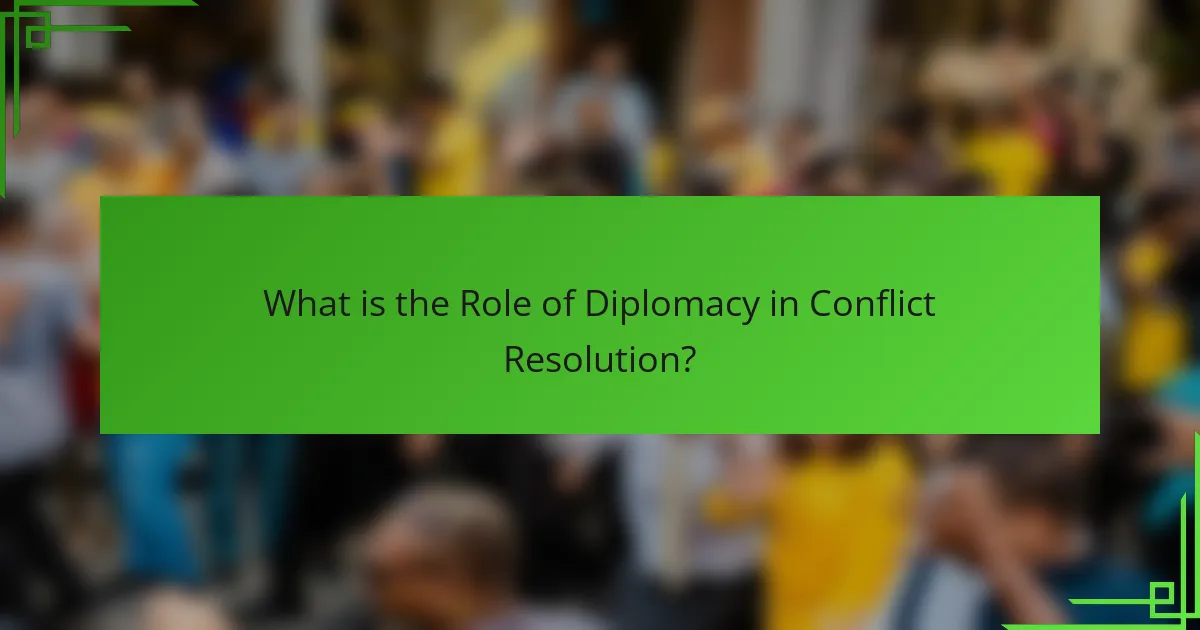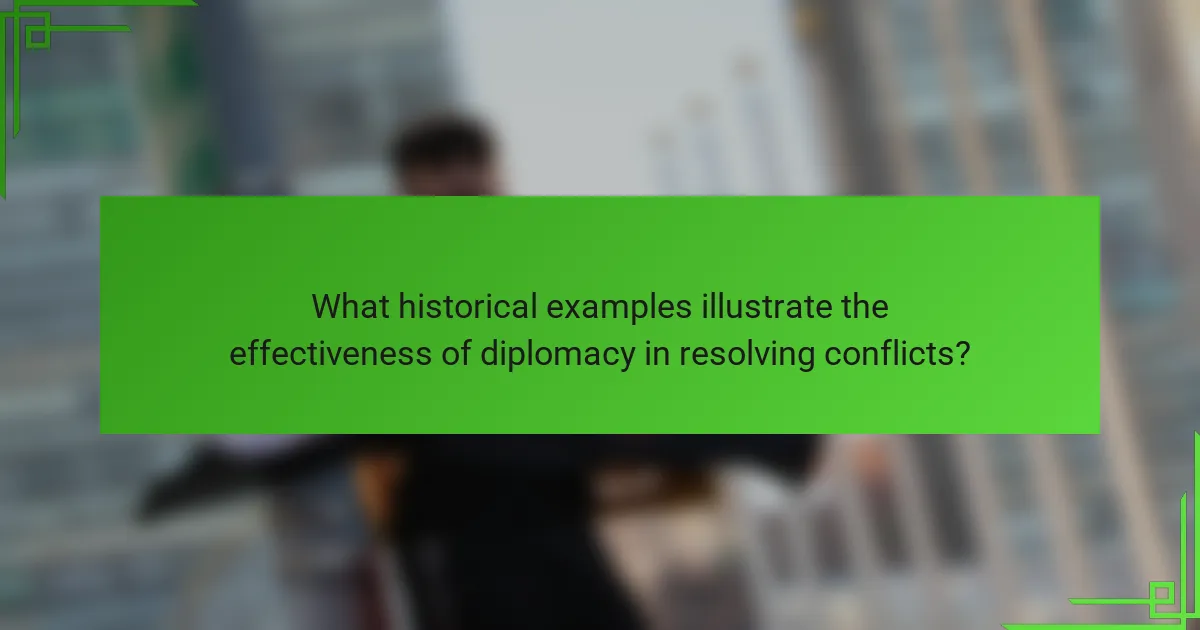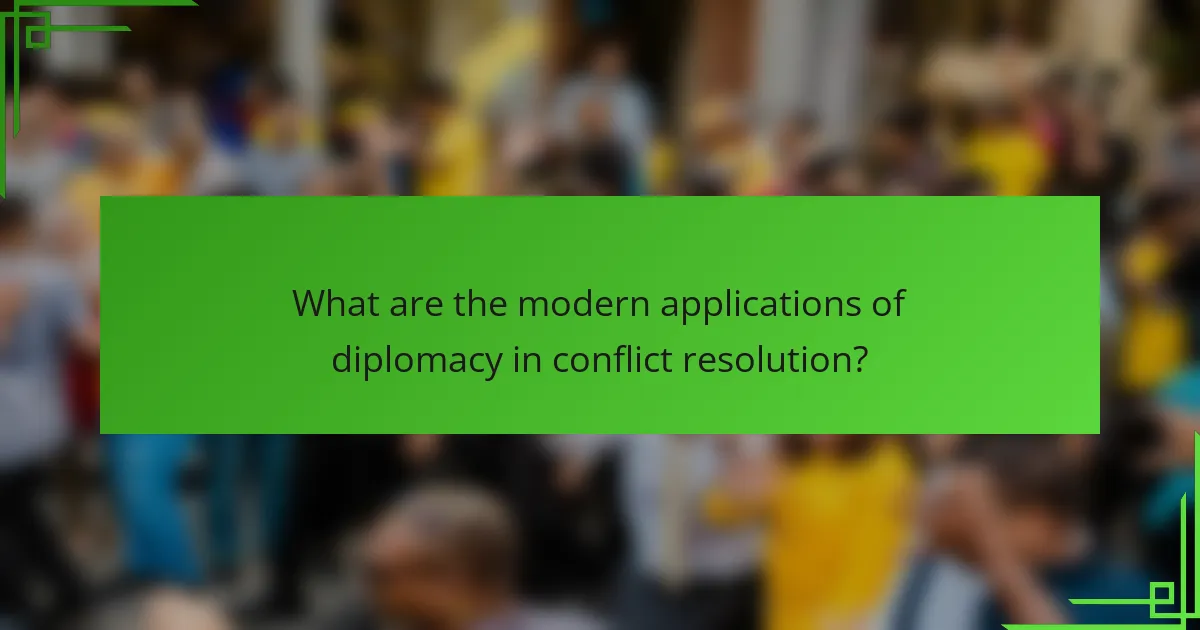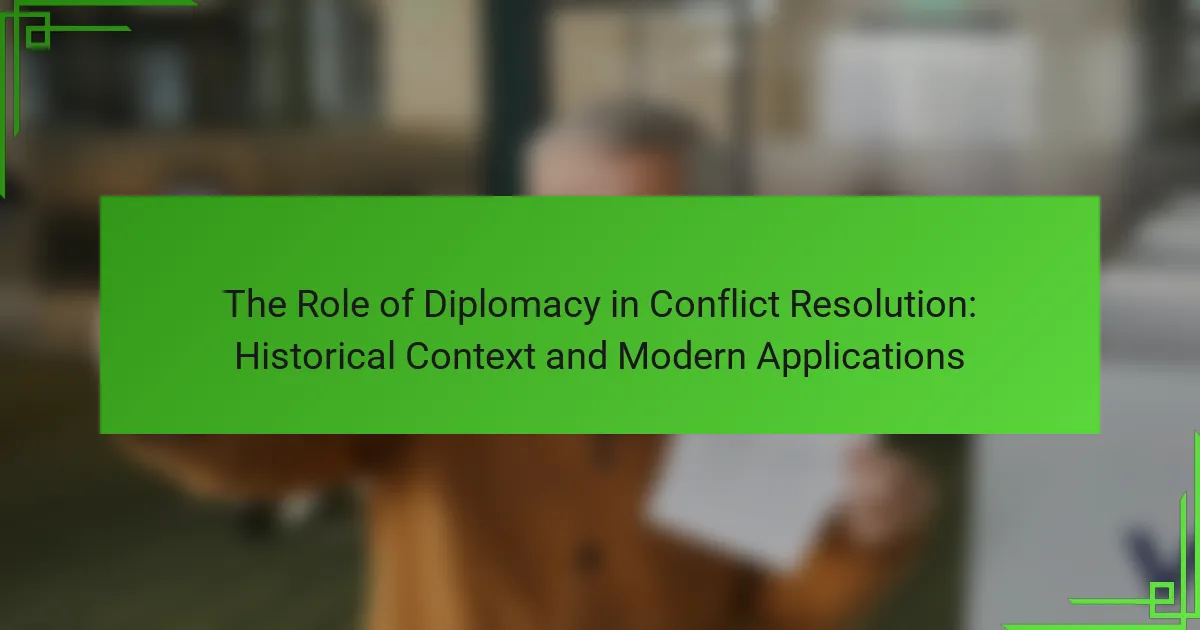Diplomacy is a key mechanism in conflict resolution, facilitating dialogue and negotiation between conflicting parties to prevent escalation and achieve mutually acceptable solutions. Historical instances, such as the Treaty of Westphalia, the Camp David Accords, and the Helsinki Accords, illustrate the effectiveness of diplomatic efforts in resolving conflicts and establishing lasting peace. Modern applications of diplomacy include mediation, negotiation, and peacekeeping, often supported by international law and track II diplomacy. These strategies demonstrate the evolving role of diplomacy in managing conflicts and fostering stability in various global contexts.

What is the Role of Diplomacy in Conflict Resolution?
Diplomacy plays a crucial role in conflict resolution by facilitating dialogue between conflicting parties. It aims to prevent escalation and find mutually acceptable solutions. Through negotiation, diplomacy seeks to address underlying issues and grievances. Diplomatic efforts often involve mediators who guide discussions and propose compromises. Historical examples, such as the Camp David Accords, illustrate successful diplomatic interventions. Additionally, diplomatic channels allow for the exchange of information and perspectives, fostering understanding. Effective diplomacy can lead to lasting peace agreements and stability. Research shows that diplomatic negotiations are often more successful than military interventions in resolving conflicts.
How has diplomacy evolved as a tool for conflict resolution?
Diplomacy has evolved significantly as a tool for conflict resolution over the centuries. Historically, diplomacy focused on negotiations between sovereign states to prevent wars. The Peace of Westphalia in 1648 marked a shift towards formalized diplomatic relations. In the 20th century, the establishment of the League of Nations and later the United Nations further institutionalized diplomacy.
Modern diplomacy now includes multilateral negotiations, involving multiple countries and international organizations. The rise of non-state actors has also changed the diplomatic landscape. Today, diplomacy incorporates various forms of communication, including digital diplomacy.
The effectiveness of diplomacy is evident in numerous peace treaties and conflict resolution efforts, such as the Camp David Accords in 1978. These developments reflect the ongoing adaptation of diplomacy to address complex global challenges.
What historical events shaped the development of diplomatic practices?
The development of diplomatic practices has been shaped by several key historical events. The Treaty of Westphalia in 1648 established principles of state sovereignty and non-interference, which are foundational to modern diplomacy. The Congress of Vienna in 1815 introduced collective security and balance of power concepts, influencing diplomatic negotiations. The establishment of the League of Nations after World War I aimed to promote peace through diplomacy and prevent conflicts. The United Nations, formed in 1945, further formalized diplomatic relations among nations. The Cold War era saw the emergence of new diplomatic strategies, including détente and negotiation, to manage tensions. Each of these events contributed to evolving diplomatic norms and practices that continue to shape international relations today.
How do different cultures approach diplomacy in conflict situations?
Different cultures approach diplomacy in conflict situations through varied methods and philosophies. For instance, Western cultures often prioritize direct negotiation and legal frameworks. They emphasize formal agreements and documentation. In contrast, many Asian cultures value indirect communication and relationship-building. They focus on harmony and consensus rather than confrontation. Middle Eastern cultures may employ a blend of personal relationships and tribal affiliations in their diplomatic efforts. Historical examples include the Camp David Accords, where direct negotiation led to peace between Egypt and Israel. These cultural approaches shape the effectiveness and strategies of diplomatic efforts globally.
What are the key principles of diplomacy in conflict resolution?
The key principles of diplomacy in conflict resolution include negotiation, communication, and compromise. Negotiation allows conflicting parties to discuss their issues openly. Effective communication fosters understanding and builds trust between parties. Compromise involves finding a middle ground that satisfies both sides. These principles are supported by historical examples, such as the Camp David Accords in 1978, where negotiation and compromise led to a peace agreement between Egypt and Israel. Additionally, the role of third-party mediators often enhances these principles, facilitating dialogue and offering neutral perspectives.
What is the significance of negotiation in diplomatic efforts?
Negotiation is crucial in diplomatic efforts as it facilitates communication and understanding between conflicting parties. It allows for the exploration of mutual interests and potential compromises. Historical examples, such as the Camp David Accords in 1978, illustrate how negotiation can lead to significant peace agreements. The successful negotiation process can prevent conflicts from escalating into violence. Moreover, negotiation fosters long-term relationships and stability among nations. It serves as a tool for addressing grievances and resolving disputes without resorting to force. Ultimately, effective negotiation is foundational in achieving diplomatic goals and maintaining global peace.
How does communication influence the outcomes of diplomatic negotiations?
Communication significantly influences the outcomes of diplomatic negotiations. Effective communication fosters understanding and trust between negotiating parties. Clear articulation of interests and concerns can lead to mutually beneficial agreements. Miscommunication, on the other hand, often results in misunderstandings and conflict escalation. Historical examples, such as the Camp David Accords, demonstrate how effective dialogue facilitated peace between Israel and Egypt. The ability to listen actively and respond appropriately is crucial in negotiations. Studies show that non-verbal cues also play a vital role in conveying intentions and emotions. Overall, successful negotiations hinge on the quality of communication employed by the involved parties.

What historical examples illustrate the effectiveness of diplomacy in resolving conflicts?
The Treaty of Westphalia in 1648 is a historical example illustrating the effectiveness of diplomacy in resolving conflicts. This treaty ended the Thirty Years’ War in Europe. It established principles of state sovereignty and non-interference. The negotiations involved multiple nations and took several years. The resulting peace helped stabilize Europe and laid the groundwork for modern international relations.
Another example is the Camp David Accords in 1978. These accords were a peace agreement between Egypt and Israel. U.S. President Jimmy Carter facilitated the negotiations. The accords led to Israel’s withdrawal from the Sinai Peninsula. This agreement marked a significant step toward peace in the Middle East.
The Helsinki Accords of 1975 also demonstrate diplomatic effectiveness. This agreement involved 35 countries, including the U.S. and the Soviet Union. It aimed to improve relations between the Eastern and Western blocs during the Cold War. The accords promoted human rights and economic cooperation.
These examples show how diplomacy can effectively resolve conflicts and lead to lasting peace.
How did the Treaty of Westphalia impact modern diplomacy?
The Treaty of Westphalia established principles that shaped modern diplomacy. It marked the end of the Thirty Years’ War in 1648. The treaty recognized state sovereignty as a fundamental principle. This meant that states could govern themselves without external interference. Additionally, it introduced formal diplomatic recognition between states. This laid the groundwork for international law and diplomatic protocols. The treaty’s principles influenced the development of the nation-state system. This system remains central to global diplomacy today.
What lessons can be learned from the Congress of Vienna?
The Congress of Vienna teaches the importance of diplomacy in conflict resolution. It demonstrates how negotiation can lead to lasting peace. The Congress, held in 1814-1815, aimed to restore stability in Europe after the Napoleonic Wars. Key figures included Klemens von Metternich and Tsar Alexander I. They prioritized collective security and balance of power. This approach helped prevent major conflicts in Europe for decades. The Congress also highlighted the need for compromise among nations. It showed that inclusive dialogue can address diverse interests effectively. These lessons remain relevant in contemporary diplomacy and conflict resolution strategies.
What role did diplomacy play during the Cold War?
Diplomacy played a crucial role in managing tensions during the Cold War. It facilitated communication between superpowers, primarily the United States and the Soviet Union. Key diplomatic efforts included treaties like the Nuclear Non-Proliferation Treaty of 1968. These treaties aimed to prevent the spread of nuclear weapons. Diplomatic summits, such as the Geneva Summit in 1955, allowed leaders to discuss differences. The establishment of hotlines, like the Moscow-Washington hotline, enabled direct communication to prevent misunderstandings. Additionally, diplomacy helped to resolve conflicts in proxy wars. It provided a platform for negotiation and dialogue, reducing the risk of direct military confrontation. Overall, diplomacy was essential in maintaining a fragile peace during a period of intense rivalry.
How did diplomatic strategies help prevent direct military conflicts?
Diplomatic strategies helped prevent direct military conflicts by facilitating communication and negotiation between opposing parties. These strategies often included treaties, mediation, and dialogue, which addressed grievances before they escalated. For instance, the Treaty of Versailles in 1919 aimed to resolve tensions post-World War I, reducing the likelihood of future wars. Additionally, the use of backchannel communications during the Cold War allowed for de-escalation of potential conflicts, exemplified by the Cuban Missile Crisis negotiations. Historical evidence shows that countries engaging in diplomacy are less likely to resort to military action, as seen in the European Union’s role in maintaining peace among member states. Overall, effective diplomatic efforts create frameworks for peaceful conflict resolution, reducing the need for military intervention.

What are the modern applications of diplomacy in conflict resolution?
Modern applications of diplomacy in conflict resolution include mediation, negotiation, and peacekeeping. Mediation involves third-party facilitators helping conflicting parties reach an agreement. Negotiation is a direct dialogue between parties to resolve differences. Peacekeeping missions deploy international forces to maintain stability in conflict zones. These methods have been used in various global conflicts, such as the Camp David Accords in 1978. The United Nations frequently employs these strategies to mitigate disputes. Diplomacy also leverages international law to address grievances. Additionally, track II diplomacy engages unofficial actors to foster dialogue. These applications demonstrate the evolving role of diplomacy in contemporary conflict management.
How do international organizations facilitate diplomatic efforts today?
International organizations facilitate diplomatic efforts today by providing platforms for dialogue and negotiation. They enable member states to engage in discussions on global issues. Organizations like the United Nations and the European Union mediate conflicts and promote peace initiatives. They also offer technical assistance and resources for capacity building in diplomacy. Additionally, these organizations monitor compliance with international agreements. They often deploy peacekeeping missions to stabilize regions in conflict. By fostering collaboration, they enhance multilateral diplomacy and collective security. Data from the UN shows that peacekeeping operations have helped reduce violence in numerous conflict zones.
What role does the United Nations play in conflict resolution through diplomacy?
The United Nations plays a crucial role in conflict resolution through diplomacy. It facilitates dialogue among conflicting parties to promote peaceful solutions. The UN employs various mechanisms, such as mediation and negotiation, to address disputes. Its peacekeeping missions often support diplomatic efforts by providing stability in conflict zones. The UN Security Council can impose sanctions or authorize military action if diplomacy fails. Historical examples include the UN’s involvement in the Korean War and the peace processes in the Middle East. The organization’s commitment to international law underpins its diplomatic initiatives. These efforts aim to maintain global peace and security, reflecting the UN’s foundational mission.
What challenges do modern diplomats face in conflict resolution?
Modern diplomats face numerous challenges in conflict resolution. These challenges include navigating complex geopolitical landscapes. They must address diverse cultural perspectives and historical grievances. Additionally, diplomats encounter the influence of non-state actors and transnational issues. Rapid technological changes complicate communication and information dissemination. Furthermore, limited resources and political constraints often hinder effective negotiation. The rise of populism can also undermine traditional diplomatic efforts. Lastly, maintaining public support while pursuing diplomatic solutions remains a significant obstacle.
How does globalization affect diplomatic relations and conflict resolution?
Globalization enhances diplomatic relations and conflict resolution by increasing interdependence among nations. This interconnectedness fosters dialogue and cooperation. Countries are more likely to engage in diplomatic negotiations to address shared challenges. Globalization also promotes the exchange of ideas and cultures, which can reduce misunderstandings. Economic ties created by globalization incentivize peaceful resolutions to conflicts. For instance, nations with strong trade relationships tend to avoid military confrontations. Furthermore, international organizations play a crucial role in mediating conflicts in a globalized world. They provide platforms for negotiation and conflict resolution, as seen in the United Nations’ peacekeeping efforts. Overall, globalization shapes diplomatic practices and conflict resolution strategies significantly.
What best practices can enhance the effectiveness of diplomacy in conflict resolution?
Effective diplomacy in conflict resolution can be enhanced by several best practices. First, establishing open communication channels is crucial. This allows for the exchange of ideas and concerns. Second, understanding cultural contexts fosters mutual respect. Knowledge of cultural nuances can prevent misunderstandings. Third, active listening demonstrates empathy and validates opposing viewpoints. This approach builds trust among conflicting parties. Fourth, employing neutral mediators can facilitate unbiased discussions. Neutrality helps maintain a balanced dialogue. Fifth, setting clear objectives ensures that all parties understand the desired outcomes. Clarity in goals can streamline negotiations. Finally, maintaining flexibility allows for adaptability in discussions. This can lead to innovative solutions that satisfy all parties involved.
How can diplomats build trust among conflicting parties?
Diplomats can build trust among conflicting parties through consistent communication and transparency. Open dialogue allows for the exchange of views and concerns. This process helps to clarify misunderstandings that may exist. Additionally, diplomats should actively listen to all parties involved. By acknowledging each party’s perspectives, they demonstrate respect and validation. Establishing common goals can also foster cooperation. When parties work towards shared objectives, they are more likely to trust each other. Furthermore, diplomats can facilitate confidence-building measures. These measures may include agreements on small, manageable issues to create a foundation of trust. Historical examples, such as the Camp David Accords, illustrate how effective diplomacy can resolve conflicts through trust-building initiatives.
What strategies can improve negotiation outcomes in diplomatic efforts?
Effective strategies to improve negotiation outcomes in diplomatic efforts include thorough preparation, active listening, and building rapport. Preparation involves understanding the interests and positions of all parties. This knowledge helps negotiators identify common ground. Active listening ensures that all viewpoints are acknowledged, fostering trust. Building rapport creates a positive atmosphere, encouraging open dialogue. Additionally, employing problem-solving techniques can lead to mutually beneficial solutions. Historical examples, such as the Camp David Accords, demonstrate the effectiveness of these strategies in achieving lasting agreements.
The main entity of the article is diplomacy, specifically its role in conflict resolution. The article examines the evolution of diplomatic practices, highlighting key historical events that have shaped modern diplomacy, such as the Treaty of Westphalia and the Camp David Accords. It discusses various cultural approaches to diplomacy, the principles guiding effective negotiation, and the significance of communication in achieving successful outcomes. Additionally, the article explores the challenges faced by modern diplomats and the impact of globalization on diplomatic relations, while providing best practices for enhancing the effectiveness of diplomacy in resolving conflicts.
